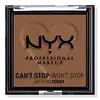about-face Curtain Call Set & Smooth Loose Powder Versus NYX Cosmetics Can't Stop Won't Stop Mattifying Powder
What's inside
What's inside
 Key Ingredients
Key Ingredients

 Benefits
Benefits

No benefits
 Concerns
Concerns

 Ingredients Side-by-side
Ingredients Side-by-side

Mica
Cosmetic ColorantZea Mays Starch
AbsorbentSilica
AbrasiveMagnesium Myristate
Kaolin
AbrasiveDistarch Phosphate
AbsorbentCoco-Caprylate/Caprate
EmollientDiatomaceous Earth
AbrasiveSqualane
EmollientMagnesium Stearate
Cosmetic ColorantEthylhexylglycerin
Skin Conditioning1,2-Hexanediol
Skin ConditioningCaprylyl Glycol
EmollientOctyldodecyl PCA
EmollientTocopheryl Acetate
AntioxidantWater
Skin ConditioningRhodochrosite Extract
AntioxidantTocopherol
AntioxidantPentylene Glycol
Skin ConditioningMagnesium Aspartate
Skin ConditioningZinc Gluconate
Skin ConditioningYeast Extract
Skin ConditioningCopper Gluconate
Skin ConditioningPhenoxyethanol
PreservativeSorbic Acid
PreservativeCI 77491
Cosmetic ColorantCI 77492
Cosmetic ColorantCI 77499
Cosmetic ColorantMica, Zea Mays Starch, Silica, Magnesium Myristate, Kaolin, Distarch Phosphate, Coco-Caprylate/Caprate, Diatomaceous Earth, Squalane, Magnesium Stearate, Ethylhexylglycerin, 1,2-Hexanediol, Caprylyl Glycol, Octyldodecyl PCA, Tocopheryl Acetate, Water, Rhodochrosite Extract, Tocopherol, Pentylene Glycol, Magnesium Aspartate, Zinc Gluconate, Yeast Extract, Copper Gluconate, Phenoxyethanol, Sorbic Acid, CI 77491, CI 77492, CI 77499
 Reviews
Reviews

Ingredients Explained
These ingredients are found in both products.
Ingredients higher up in an ingredient list are typically present in a larger amount.
Caprylyl Glycol is a humectant and emollient, meaning it attracts and preserves moisture.
It is a common ingredient in many products, especially those designed to hydrate skin. The primary benefits are retaining moisture, skin softening, and promoting a healthy skin barrier.
Though Caprylyl Glycol is an alcohol derived from fatty acids, it is not the kind that can dry out skin.
This ingredient is also used as a preservative to extend the life of products. It has slight antimicrobial properties.
Learn more about Caprylyl GlycolPhenoxyethanol is a preservative that has germicide, antimicrobial, and aromatic properties. Studies show that phenoxyethanol can prevent microbial growth. By itself, it has a scent that is similar to that of a rose.
It's often used in formulations along with Caprylyl Glycol to preserve the shelf life of products.
Silica, also known as silicon dioxide, is a naturally occurring mineral. It is used as a fine, spherical, and porous powder in cosmetics.
Though it has exfoliant properties, the function of silica varies depending on the product.
The unique structure of silica enhances the spreadability and adds smoothness, making it a great texture enhancer.
It is also used as an active carrier, emulsifier, and mattifier due to its ability to absorb excess oil.
In some products, tiny microneedles called spicules are made from silica or hydrolyzed sponge. When you rub them in, they lightly polish away dead skin layers and enhance the penetration of active ingredients.
Learn more about Silica